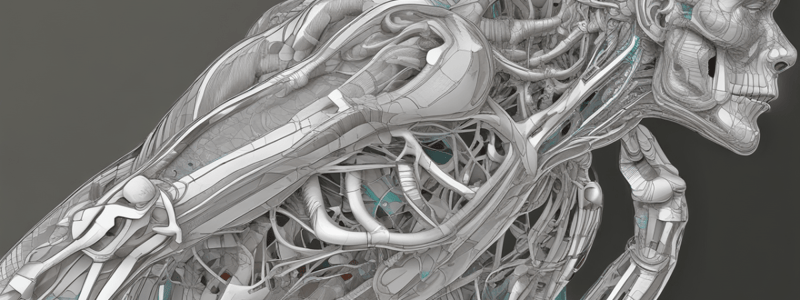Podcast
Questions and Answers
What is the maximum range of motion for shoulder flexion?
What is the maximum range of motion for shoulder flexion?
- 160°
- 170°
- 180° (correct)
- 150°
During shoulder extension, what is the maximum range of motion?
During shoulder extension, what is the maximum range of motion?
- 50°
- 40°
- 60° (correct)
- 70°
How many degrees of motion are possible in shoulder internal rotation?
How many degrees of motion are possible in shoulder internal rotation?
- 60°
- 70° (correct)
- 90°
- 80°
Shoulder horizontal abduction has a range of motion of up to how many degrees?
Shoulder horizontal abduction has a range of motion of up to how many degrees?
The range of motion for shoulder horizontal adduction extends up to how many degrees?
The range of motion for shoulder horizontal adduction extends up to how many degrees?
What is the range of motion (ROM) position for shoulder internal rotation?
What is the range of motion (ROM) position for shoulder internal rotation?
What is the muscle manual testing (MMT) position for shoulder internal rotation?
What is the muscle manual testing (MMT) position for shoulder internal rotation?
What is the range of motion (ROM) position for shoulder external rotation?
What is the range of motion (ROM) position for shoulder external rotation?
What is the muscle manual testing (MMT) position for shoulder external rotation?
What is the muscle manual testing (MMT) position for shoulder external rotation?
Which of the following positions is used for measuring both shoulder internal and external rotation ROM?
Which of the following positions is used for measuring both shoulder internal and external rotation ROM?
Which body part should be stabilized during shoulder internal rotation?
Which body part should be stabilized during shoulder internal rotation?
Where is resistance applied during shoulder external rotation?
Where is resistance applied during shoulder external rotation?
What part of the body should be stabilized during elbow extension?
What part of the body should be stabilized during elbow extension?
Where is resistance applied during elbow extension?
Where is resistance applied during elbow extension?
During shoulder internal rotation, where is resistance applied?
During shoulder internal rotation, where is resistance applied?
What is the maximum range of motion for elbow flexion?
What is the maximum range of motion for elbow flexion?
What is the range of motion for elbow pronation?
What is the range of motion for elbow pronation?
What is the maximum range of motion for wrist flexion?
What is the maximum range of motion for wrist flexion?
What is the range of motion for wrist ulnar deviation?
What is the range of motion for wrist ulnar deviation?
What is the maximum range of motion for wrist extension?
What is the maximum range of motion for wrist extension?
What is the stationary landmark for measuring shoulder flexion?
What is the stationary landmark for measuring shoulder flexion?
Which landmark is used as the axis for measuring shoulder abduction?
Which landmark is used as the axis for measuring shoulder abduction?
For shoulder extension measurement, what is the moving landmark?
For shoulder extension measurement, what is the moving landmark?
The greater tubical is a landmark for which shoulder movements?
The greater tubical is a landmark for which shoulder movements?
Which landmark is unique to shoulder abduction and not used in flexion or extension?
Which landmark is unique to shoulder abduction and not used in flexion or extension?
Which muscle is involved in wrist flexion and radial deviation?
Which muscle is involved in wrist flexion and radial deviation?
Which muscles are involved in wrist extension?
Which muscles are involved in wrist extension?
Which muscle specifically should be palpated to test for wrist flexion?
Which muscle specifically should be palpated to test for wrist flexion?
Which muscle is not involved in wrist extension?
Which muscle is not involved in wrist extension?
Which muscle is not listed as one to be palpated for wrist flexion?
Which muscle is not listed as one to be palpated for wrist flexion?
Which of the following is used as a landmark for wrist flexion and extension measurements?
Which of the following is used as a landmark for wrist flexion and extension measurements?
Which bone is used as a landmark for wrist deviation measurement?
Which bone is used as a landmark for wrist deviation measurement?
What landmark is used in both wrist flexion/extension and wrist deviation measurements?
What landmark is used in both wrist flexion/extension and wrist deviation measurements?
Which of the following landmarks is NOT used for wrist flexion and extension?
Which of the following landmarks is NOT used for wrist flexion and extension?
For wrist deviation, which landmark bisects the forearm?
For wrist deviation, which landmark bisects the forearm?
Flashcards are hidden until you start studying
Study Notes
Shoulder Range of Motion
- The shoulder joint has a range of motion of 0-180° in flexion, allowing for full forward elevation of the arm.
- In extension, the shoulder joint can move 0-60°, enabling the arm to be moved backward.
- Abduction, or the movement of the arm away from the midline, has a range of 0-180°, allowing for full lateral elevation.
- Internal rotation, or the rotation of the arm inward, has a range of 0-70°, permitting the arm to be rotated inward.
- External rotation, or the rotation of the arm outward, has a range of 0-90°, allowing for the arm to be rotated outward.
- Horizontal abduction, or the movement of the arm away from the midline in the horizontal plane, has a range of 0-45°.
- Horizontal adduction, or the movement of the arm towards the midline in the horizontal plane, has a range of 0-135°.
Shoulder Range of Motion
- Shoulder flexion ranges from 0 to 180 degrees.
- Shoulder extension ranges from 0 to 60 degrees.
- Shoulder abduction ranges from 0 to 180 degrees.
- Shoulder internal rotation ranges from 0 to 70 degrees.
- Shoulder external rotation ranges from 0 to 90 degrees.
- Horizontal shoulder abduction ranges from 0 to 45 degrees.
- Horizontal shoulder adduction ranges from 0 to 135 degrees.
Shoulder Internal Rotation Position
- Internal rotation range of motion (ROM) is assessed in the supine position.
- Internal rotation manual muscle test (MMT) is performed in the prone position.
Shoulder External Rotation Position
- External rotation range of motion (ROM) is assessed in the supine position.
- External rotation manual muscle test (MMT) is performed in the prone position.
Shoulder Internal Rotation
- Scapula is responsible for stabilization
- Proximal wrist provides resistance
Shoulder External Rotation
- Scapula is responsible for stabilization
- Proximal wrist provides resistance
Elbow Extension
- Distal humerus is responsible for stabilization
- Distal forearm provides resistance
Wrist Muscles
- Flexion/Radial muscles include flexor carpi radialis (palpated) and flexor carpi ulnaris
- Extension muscles include extensor carpi radialis, extensor carpi ulnaris, and brevis
Elbow Range of Motion
- Flexion: 0-150°
- Extension: 0°
- Pronation: 0-80°
- Supination: 0-80°
Wrist Range of Motion
- Flexion: 0-80°
- Extension: 0-70°
- Ulnar deviation: 0-300°
- Radial deviation: 0-200°
Shoulder ROM Landmarks
- 'S' landmark is the mid-line of the thorax
- 'M' landmark is the lateral condyle
- 'A' landmark is the greater tubical (side of the armpit)
Abduction
- 'S' landmark is the mid-line of the thorax (inside of the armpit)
- 'M' landmark is the lateral condyle
- 'A' landmark is the acromion
- '5' landmark is parallel to the sternum
- 'M' landmark is bisecting the humerus
Wrist Flexion & Extension
- Landmarks include the olecranon process, triquetrum, and 5th metacarpal
Wrist Deviation
- Landmarks include the bisecting forearm, capitate, and 3rd metacarpal
Studying That Suits You
Use AI to generate personalized quizzes and flashcards to suit your learning preferences.




